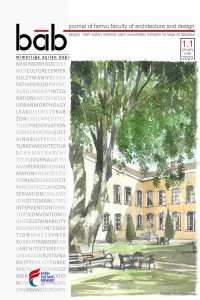Abstract
This paper argues that higher quality built environments can never be commodified, but rather should evolve from its inhabitants. Nowadays, users can choose from what is already produced by profit seeking industries, yet they cannot decide their manufacturing specifications. Environmental elements or configurations are no exception. Capitalism with its Western mode of production resulted in shaping built environments all over, including Muslim Middle Eastern settlements. Hence, components of the built environments such as houses and schools became commodities thus eliminating users’ participation except on the selection level from an already finished products. This process is quite different than traditional ones in the Muslim built environment in which production is based on users’ control. I.e., production is not based on participation as one might think, but rather on the power of controlling all environmental configuration by residents at all levels. This process, as the paper argues, will have massive positive impacts such as sustainability. The paper depicts three major mechanisms to delineate the process of creating built environments with the least possible cost yet leading to much higher qualities than those created by capitalism. The three mechanism are: 1) reducing land value as much as possible to an affordable level for the masses; 2) environmental decisions are based on the principle of damage leading to “accretions of decisions” with no external interventions; 3) deep territorial structure to further concentrate responsibilities in the hands of local inhabitants. Thus all three leading to environmental knowledge based on local control and thus responding to local needs, ambiance and materials resulting in sustainable environments. In summary, environmentally, commodification of capitalism is the archenemy of sustainability.
Keywords
References
- ABD AL-WAHAB, H., nd. Takhtit al-Qahirah wa Tanzimaha. Cairo: Dar an-Nashr lil-Jami‘at Press. AKBAR, J., 2019. Rights and civilizations. In: The Future of the Built Environment. ISL@H ,26-28 August 2019, İstanbul. Turkey: FSMVU Yayınları. pp. 39-68. AKBAR, J., 2020. Qas al-Haq. Jordan: Alama al-Ktob, 3 Vols. AKBAR, J., 1993. Gates as signs of autonomy in Muslim towns. Muqarnas: An Annual on Islamic Art and Architecture. (10), pp. 141-147. AKBAR, J., 1988. Crisis in the built environment: the case of the Muslim city. Singapore: Concept Media. AKBAR, J., 1987. Khatta and the territorial structure of early Muslim towns. Muqarnas: An Annual on Islamic Art and Architecture. (6), pp. 22-32. AKBAR, J., 1988. Accretion of decisions: a design strategy. In: M. B. SEVCENKO, ed. Theories and principles of design in the architecture of Islamic societies. Cambridge: Massa. Aga Khan Program for Islamic Architecture. pp. 107-114. AL-BALADHURI, A., 1978. Futuh al-Buldan. Beirut: Dar al-Kutub al-‘Ilmiyyah Press. AL-MAQRIZI, T., nd. Kitab al-Mawa ‘iz wa al ‘I ‘tibar. Cairo: al-Halabi Press. 2 vols. AL-WANSHARISI. 1981. Al-Mi‘yaru al-M‘rab. Morocco: the Ministry of Endowments and Islamic Affairs. 8-9 vols. GOITEIN, S. D., 1969. Cairo: An Islamic city in the light of the Geniza documents. In: I. M. LAPİDUS, ed. Middle Eastern cities. Berkeley: U. of California Press. HABRAKEN, J., 1998. The structure of the ordinary. Cambridge: MIT press.
Abstract
References
- ABD AL-WAHAB, H., nd. Takhtit al-Qahirah wa Tanzimaha. Cairo: Dar an-Nashr lil-Jami‘at Press. AKBAR, J., 2019. Rights and civilizations. In: The Future of the Built Environment. ISL@H ,26-28 August 2019, İstanbul. Turkey: FSMVU Yayınları. pp. 39-68. AKBAR, J., 2020. Qas al-Haq. Jordan: Alama al-Ktob, 3 Vols. AKBAR, J., 1993. Gates as signs of autonomy in Muslim towns. Muqarnas: An Annual on Islamic Art and Architecture. (10), pp. 141-147. AKBAR, J., 1988. Crisis in the built environment: the case of the Muslim city. Singapore: Concept Media. AKBAR, J., 1987. Khatta and the territorial structure of early Muslim towns. Muqarnas: An Annual on Islamic Art and Architecture. (6), pp. 22-32. AKBAR, J., 1988. Accretion of decisions: a design strategy. In: M. B. SEVCENKO, ed. Theories and principles of design in the architecture of Islamic societies. Cambridge: Massa. Aga Khan Program for Islamic Architecture. pp. 107-114. AL-BALADHURI, A., 1978. Futuh al-Buldan. Beirut: Dar al-Kutub al-‘Ilmiyyah Press. AL-MAQRIZI, T., nd. Kitab al-Mawa ‘iz wa al ‘I ‘tibar. Cairo: al-Halabi Press. 2 vols. AL-WANSHARISI. 1981. Al-Mi‘yaru al-M‘rab. Morocco: the Ministry of Endowments and Islamic Affairs. 8-9 vols. GOITEIN, S. D., 1969. Cairo: An Islamic city in the light of the Geniza documents. In: I. M. LAPİDUS, ed. Middle Eastern cities. Berkeley: U. of California Press. HABRAKEN, J., 1998. The structure of the ordinary. Cambridge: MIT press.
Details
| Primary Language | English |
|---|---|
| Subjects | Architecture |
| Journal Section | Opinion Articles |
| Authors | |
| Publication Date | January 31, 2020 |
| Acceptance Date | January 13, 2020 |
| Published in Issue | Year 2020 Volume: 1 Issue: 1 |
Cite
This work is licensed under a
Creative Commons Attribution-NonCommercial-NoDerivatives 4.0 International License.

